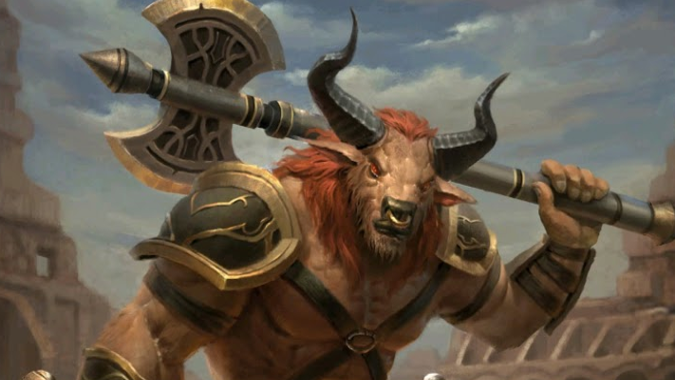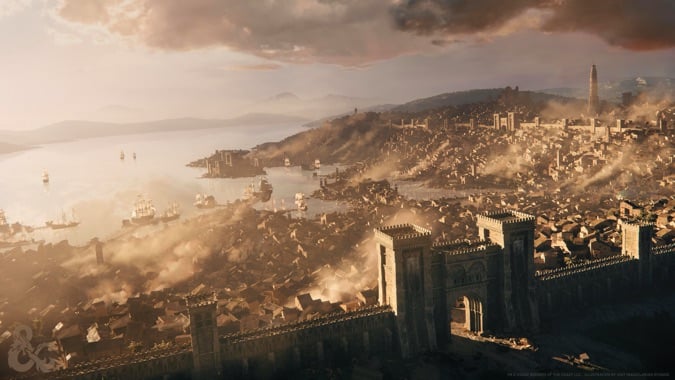What are the benefits of using a published campaign setting for your D&D game? Should you use one?

Yes.
Okay, thanks for reading. I’ll be here all week.
No, no, I kid. But the fact is, there are a lot of advantages to using an established, published campaign setting for your Dungeons and Dragons (or other tabletop RPG) games. While I often create my own campaign settings — for example, the Blizzard Watch D&D streams are in a world of my own creation — I feel very strongly that there are a lot of good reasons to run games in a setting like Faerun from the Forgotten Realms, Athas from Dark Sun, or Greyhawk from the World of Greyhawk. Often as new DMs we feel pressured to write our own settings, and it’s a lot of fun and a great creative challenge to do so. But I’m still a huge fan of campaign settings — I’ve yet to run a game in Pathfinder 2e’s Lost Omens campaign setting of Golarion, for example, but I’d love to.
People are familiar with these worlds and settings. They’re tested by time and have established fanbases. You can usually find at least one player who knows them, and they’re usually designed to have the bases of the games covered. But there’s more to it than that.

You don’t have to think of everything yourself
Part of it is that a campaign setting created by others will have surprises in it for you. You are you — by definition, there’s not going to be much inside of a campaign setting you have created that will really shock you. Many homebrew settings are labors of love, collected together over years of games, with details added by interaction with our players, but a published campaign setting has often had multiple contributors adding in details, locations, and NPCs. Even a setting like Faerun, which is clearly Ed Greenwood’s baby, has had so many writers come along and add details that it becomes an enmeshed, complex tapestry and it’s just got more depth and detail than can be easily explained. This makes for a lot of options for your weekend D&D game — probably more options than you could easily concoct yourself.
Another good reason to use a published campaign setting is it’s easier for your players to come up with character concepts and hooks for their PCs if they have access to the setting material. Now, I try and sit down and write up details for my players — trust me, you probably don’t want to ask to see my campaign materials, there’s a lot of them — but for a lot of us, there’s a lot to be said for a world like Golarion or Faerun that has all sorts of materials out there for the players to consult on their own time. Running a D&D game is a lot of fun, but there’s always a bit of a time crunch — not having to sit down and supply your players with all the elements they may require for their character and its backstory can be extremely liberating.

The work of worldbuilding is already done
This goes into the next point. A published campaign setting frees you up from having to come up with new locations and NPCs for your party. Again, there’s a lot of fun in designing your own world, coming up with all the villages and towns and isolated locations, but a published setting can supply you with some or even all of the framework and let you prepare the specifics within a scaffolding of already extant locales. Going from the Keep on the Borderlands to the Village of Hommlet gives you a predetermined path and if your players decide to deviate, you don’t have to scramble to figure out where they’d end up, you know that Verbobonc is close, and that if they decide to go wider afield they could end up in Dyvers or Nulb. Some campaign settings are massive, and cover entire expansive continents worth of nations and city states and wilderness to explore and it can be very helpful in keeping a party of adventurers entertained.
It’s also helpful if you’re the kind of DM who makes use of published adventures and modules if those adventures and modules are already set in a campaign setting. A lot of official D&D adventures, like the upcoming Icewind Dale: Rime of the Frostmaiden are set in a campaign setting — Icewind Dale is a town to the far north of the Faerun setting, and thus, part of the Forgotten Realms. If you’re already running a game in Faerun, you don’t have to try and adapt the adventure as much — just have the players go north and end up in the Ten Towns of Icewind Dale.
There’s absolutely nothing wrong with having someone else do the work of designing the setting for you. If you were running a Star Wars game, someone else did the work of designing that setting for you — there’s no real difference. Heck, you could run a Warcraft game, using Azeroth as your campaign setting, and that would be much the same as buying a campaign setting book, except you’d be using the old Warcraft and World of Warcraft published RPG books as your setting materials. And there’s absolutely nothing wrong with that.

It’s helpful to see how other people built their worlds
Even if you’re the kind of DM who designs their own homebrew settings, published settings are pretty awesome places to disassemble for ideas. I’ve already written in the past about how much I love older D&D materials — I’m a huge fan of Mystara and Greyhawk, for example. But reading through their campaign setting books, such as the amazing Gazetteer series, often lets me think differently about my own home game. If the older campaign did a lot of something I don’t like — for example, constantly having nations and cultures be male dominated — I can think about why it does that, and how I can learn from it. I really think more D&D campaigns could learn from the Eberron setting and its cool, magical trains and airships — it definitely has a kind of post-WW1 feel to it, with the devastation of the Mournland and the kind of strangely fraught tension between nations. It’s an interestingly noirish take on D&D. I admit to having stolen the airships for my Riatan game. Trains felt a bit too modern to me, but I liked airships.
Similarly, I read Odyssey of the Dragonlords cover to cover and I think it’s one of the most ingenious new campaign worlds in years. I used quite a few ideas from it in the one-shot Theros game I ran, and if we went back to Theros for an extended game I’d definitely steal a lot more from it.
Ultimately, I’m a big fan of published campaign settings and I recommend them to all DMs. They’re great for a variety of reasons — they’re fun, they have lots of ideas for you to use, they can serve as inspiration or let you get straight to playing, and they allow for a lot of creativity within the framework they provide. If you think about it, they allow games like D&D to embrace a wider variety of play and support more players, which I think is pretty awesome.
Please consider supporting our Patreon!
Join the Discussion
Blizzard Watch is a safe space for all readers. By leaving comments on this site you agree to follow our commenting and community guidelines.
 @MatthewWRossi
@MatthewWRossi





